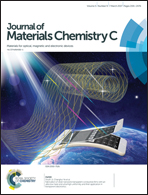Facile synthesis of water soluble fluorescent metal (Pt, Au, Ag and Cu) quantum clusters for the selective detection of Fe3+ ions as both fluorescent and colorimetric probes†
Abstract
A facile and green synthetic route is developed to prepare water soluble, green-fluorescent Pt, Au, Ag and Cu quantum clusters (QCs), employing innoxious L-histidine as a capping agent. These metal QCs give out emissions at 455–495 nm, with maximum excitation wavelengths ranging between 350 and 401 nm. Interestingly, these histidine-stabilized metal quantum clusters also possess non-linear optical properties like two-photon luminescence, which is detected when they are exposed to a femtosecond laser at 812 nm. Luminescence quantum yields of Pt (2.93%), Au (13.10%), Ag (6.97%) and Cu (8.29%) clusters are found to be distinctly different, and lifetime measurement results suggest that the emissions of metal clusters (4.59–7.39 ns) stem from singlet transitions among different electron energy levels rather than metal–ligand electron transfer behaviors. The Pt, Au, Ag and Cu quantum clusters have average sizes of 1.3–1.9 nm, and are mainly composed of 11, 9, 4 and 7 metal atoms, respectively, according to the electrospray ionization mass spectrometry results. Moreover, the as-prepared metal clusters are sensitive to aqueous ferric ions, both as highly selective fluorescent and colorimetric probes in a low and wide concentration range, and are promising in many biological applications.



 Please wait while we load your content...
Please wait while we load your content...